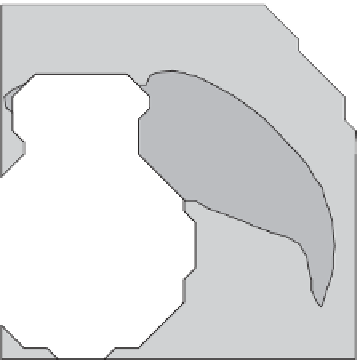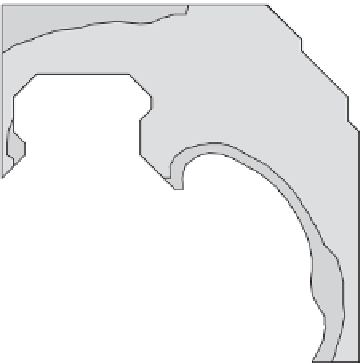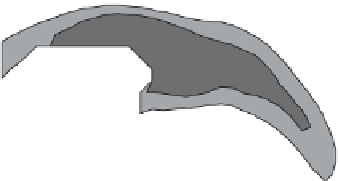Geoscience Reference
In-Depth Information
(a)
(b)
Real EOF2 19.4251%
Imaginary EOF2 19.4251%
55
55
0.25
0.25
50
50
0.2
0.2
45
45
0.15
0.15
40
40
0.1
0.1
35
35
0.05
0.05
30
30
0
0
−0.05
−0.05
25
25
−0.1
−0.1
20
20
−0.15
−0.15
15
15
−0.2
−0.2
10
10
−0.25
−0.25
5
5
5
10
15
20
25
30
35
40
45
50
5
10
15
20
25
30
35
40
45
50
x
(grid points)
x
(grid points)
(c)
(d)
Real EOF1 37.0297%
Imaginary EOF1 37.0297%
50
50
0.6
0.2
0.4
45
45
0
0.2
40
40
−0.2
0
35
35
−0.2
−0.4
−0.4
30
−0.6
30
−0.6
−0.8
25
25
−0.8
−1
20
20
20
25
30
35
40
45
50
20
25
30
35
40
45
50
x
(grid points)
x
(grid points)
Figure 17.11.
Real and imaginary parts of CEOFs: surface temperature and velocity: (a,b) CEOF2 for full annulus; (c,d) CEOF1 of
upstream region. The CEOFs resolve coupled heat and velocity anomalies propagating anticlockwise toward the barrier. For color
detail, please see color plate section.
demonstrates that vortices are important in the constric-
tion even if this is not directly visible in Figure 17.8.
However, the magnitude of the vorticity in the gap is
weak compared to the vorticity in the region upstream of
the barrier. Note finally that downstream of the barrier
the anomalies become more turbulent and less coherent
features can be observed (Figures 17.11a,b).
The present experiment of a differentially heated rotat-
ing annulus with a radial barrier that partially blocks the
azimuthal component of the flow along the inner cylin-
der and the bottom enables us to present a rather general
picture of the transient flow. This picture should hold for
a certain range of Taylor and thermal Rossby numbers
in the wave regime of the annulus. Roughly speaking,
the annulus can be subdivided into the half upstream
of the barrier, where waves amplify, and the half down-
stream of the barrier, where waves decay (see Figures 17.8
and 17.11). The dominant linear wave mode (in our case
with azimuthal wave number 3) is unstable upstream but
stable downstream of the barrier. In the upstream half,
the azimuthal mean flow is moderate but with a signif-
icant positive radial eddy heat flux. In contrast, in the
downstream half, we find an increased radial mean tem-
perature gradient. The latter points to a weakened or


















































































































































































































































































































































































































































































































































































































































































































































































































































































































































































































































































































































